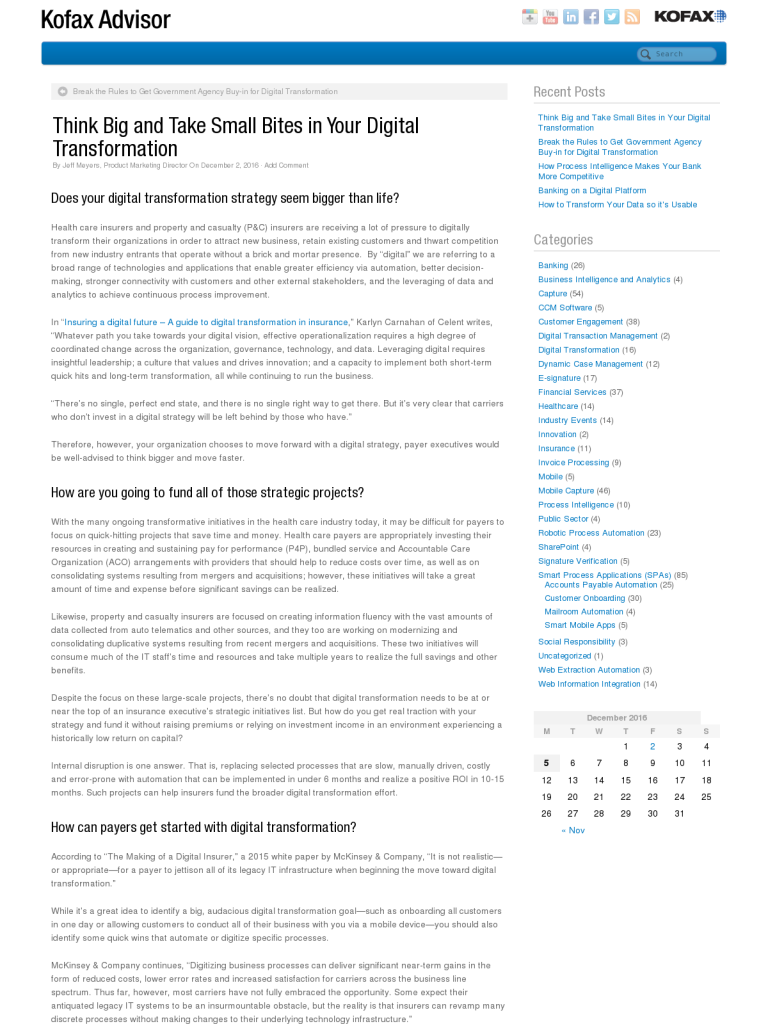Think Big and Take Small Bites in Your Digital Transformation
Blog: Kofax - Smart Process automation
Does your digital transformation strategy seem bigger than life?
Health care insurers and property and casualty (P&C) insurers are receiving a lot of pressure to digitally transform their organizations in order to attract new business, retain existing customers and thwart competition from new industry entrants that operate without a brick and mortar presence. By “digital” we are referring to a broad range of technologies and applications that enable greater efficiency via automation, better decision-making, stronger connectivity with customers and other external stakeholders, and the leveraging of data and analytics to achieve continuous process improvement.
In “Insuring a digital future – A guide to digital transformation in insurance,” Karlyn Carnahan of Celent writes, “Whatever path you take towards your digital vision, effective operationalization requires a high degree of coordinated change across the organization, governance, technology, and data. Leveraging digital requires insightful leadership; a culture that values and drives innovation; and a capacity to implement both short-term quick hits and long-term transformation, all while continuing to run the business.
“There’s no single, perfect end state, and there is no single right way to get there. But it’s very clear that carriers who don’t invest in a digital strategy will be left behind by those who have.”
Therefore, however, your organization chooses to move forward with a digital strategy, payer executives would be well-advised to think bigger and move faster.
How are you going to fund all of those strategic projects?
With the many ongoing transformative initiatives in the health care industry today, it may be difficult for payers to focus on quick-hitting projects that save time and money. Health care payers are appropriately investing their resources in creating and sustaining pay for performance (P4P), bundled service and Accountable Care Organization (ACO) arrangements with providers that should help to reduce costs over time, as well as on consolidating systems resulting from mergers and acquisitions; however, these initiatives will take a great amount of time and expense before significant savings can be realized.
Likewise, property and casualty insurers are focused on creating information fluency with the vast amounts of data collected from auto telematics and other sources, and they too are working on modernizing and consolidating duplicative systems resulting from recent mergers and acquisitions. These two initiatives will consume much of the IT staff’s time and resources and take multiple years to realize the full savings and other benefits.
Despite the focus on these large-scale projects, there’s no doubt that digital transformation needs to be at or near the top of an insurance executive’s strategic initiatives list. But how do you get real traction with your strategy and fund it without raising premiums or relying on investment income in an environment experiencing a historically low return on capital?
Internal disruption is one answer. That is, replacing selected processes that are slow, manually driven, costly and error-prone with automation that can be implemented in under 6 months and realize a positive ROI in 10-15 months. Such projects can help insurers fund the broader digital transformation effort.
How can payers get started with digital transformation?
According to “The Making of a Digital Insurer,” a 2015 white paper by McKinsey & Company, “It is not realistic—or appropriate—for a payer to jettison all of its legacy IT infrastructure when beginning the move toward digital transformation.”
While it’s a great idea to identify a big, audacious digital transformation goal—such as onboarding all customers in one day or allowing customers to conduct all of their business with you via a mobile device—you should also identify some quick wins that automate or digitize specific processes.
McKinsey & Company continues, “Digitizing business processes can deliver significant near-term gains in the form of reduced costs, lower error rates and increased satisfaction for carriers across the business line spectrum. Thus far, however, most carriers have not fully embraced the opportunity. Some expect their antiquated legacy IT systems to be an insurmountable obstacle, but the reality is that insurers can revamp many discrete processes without making changes to their underlying technology infrastructure.”
When will payers see the results of going digital?
Completing full system replacements, creating fully digital workflows that enable you to quote potential customers in minutes or onboard all new customers in one day, or allowing customers to “self-serve” for claim status inquiries and most policy changes—these are projects that can take many months to many years to implement.
However, other projects that focus on automating one or two specific processes, such as the digitization, validation, and conversion of paper-based medical claims, can take a matter of a few weeks or a few months to complete. Such projects enable carriers to increase efficiency and improve accuracy at a substantial cost savings—without a major technology infrastructure upgrade. You can implement a comprehensive claims automation solution, such as Claims Agility, to automate the sorting, routing, classification, digitization, extraction, validation, conversion (to EDI) and hand-off of only “clean claims” to the existing adjudication process. You can also use this solution to expedite the identification and resolution of true biller errors via predefined business rules and a collaborative rejection workflow. Whether you need to process single payer claims or multi-payer claims , Claims Agility can provide the automation you need to realize efficiencies.
The speed and agility with which carriers take on these challenges and convert them into opportunities for growth and performance enhancement will likely determine which companies are most effectively positioned to lead the industry. There’s no time like the present to get started on such transformations. As Yogi Berra, best known as the Hall of Fame catcher for baseball’s New York Yankees, once said, “It gets late early out there.”
To learn more about deploying automation to improve speed, accuracy and visibility across your claims process, please visit claims-agility, or contact us by clicking here.
Leave a Comment
You must be logged in to post a comment.








